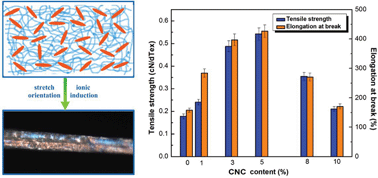Liquid crystal microphase separation of cellulose nanocrystals in wet-spun PVA composite fibers
Abstract
Remarkable mechanical performance and chiral nematic liquid crystal behavior make sulfate cellulose nanocrystals (CNCs) attractive for many researchers. However, CNCs at a low content in the composite lost their liquid crystal characters because the lyotropic mesogens of rod-like negative-charged CNCs were easily affected by external forces, such as hydrogen bonding interactions with poly(vinyl alcohol) (PVA) in the composite. In present study, the electrolyte, sodium sulfate, was introduced to induce nematic mesophases of CNCs during the coagulation process of wet-spun PVA/CNCs composite fibers. We investigated the morphology, structure and mechanical properties of the spun fiber and hypothesized a scheme to establish the mechanism of formation for the liquid crystal domain and illustrate the specific mechanical properties caused by the resultant phase separation. The recognized ionic induction effects will be quite helpful to fabricate functional liquid crystal fabrics for future industrial applications.


 Please wait while we load your content...
Please wait while we load your content...